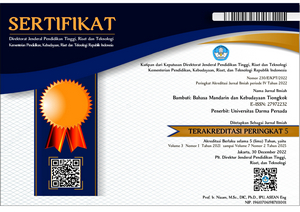MAKNA SIMBOL DAN ORNAMEN PADA BANGUNAN VIHARA GUNUNG TIMUR
THE MEANING OF SYMBOLS AND ORNAMENTS IN THE BUILDING OF VIHARA GUNUNG TIMUR
Abstract
The title of this research was ‘The Meaning of Symbols and Ornaments in the Building of Vihara Gunung Timur’. The research problems were 1) what types of symbol and ornament are found in the building of Vihara Gunung Timur? and 2) what the meaning of symbols and ornaments found in the building of Vihara Gunung Timur?. The research used descriptive qualitative method. The theory used in the research was the theory of semiotics of Charles Sanders Peirce. The data were gathered by conducting observation, interview, and documentary study and explaining the kinds of ornament the building of Vihara Gunung Timur, and 2) the symbols and ornaments in the building of the building of Vihara Gunung Timur contained the meanings: the Symbol of Chih-wen Dragon, the Ornament of Tian Lung Dragon, the Symbol of lion, the Symbols of Kwam-Im Goddess Statue, the Ornament of Hong Bird, the Ornamen Of Lotus, The Symbol of Paper Lantern, the Symbol of Drum, the Symbol of Peony, the Symbol of Geometry, the Ornament of Murals, the Ornamen of God of Gate, the Symbol of Koi Fish, the Symbol of Buddha Maitreya Statue, the Symbol of Buddha Sidharta Statue, The Symbol of Hok Tek Tjeng Sien Statue, the Symbol of Liu Ding Liu Jia Statue, the Symbols of Ou Sien Ku Statue, the Symbol of Ma Zu Statue, the Symbol of Cen Cing Tien Statue, and the Symbol of Ing Fu She Ce.
Copyright (c) 2023 Bambuti

This work is licensed under a Creative Commons Attribution 4.0 International License.

This work is licensed under a Lisensi Creative Commons Atribusi 4.0 Internasional.
Authors who publish with this journal agree to the following terms:
- Authors retain copyright and grant the journal right of first publication with the work simultaneously licensed under a Lisensi Creative Commons Atribusi 4.0 Internasional that allows others to share the work with an acknowledgment of the work's authorship and initial publication in this journal.
- Authors are able to enter into separate, additional contractual arrangements for the non-exclusive distribution of the journal's published version of the work (e.g., post it to an institutional repository or publish it in a book), with an acknowledgment of its initial publication in this journal.
- Authors are permitted and encouraged to post their work online (e.g., in institutional repositories or on their website) prior to and during the submission process, as it can lead to productive exchanges, as well as earlier and greater citation of published work (See The Effect of Open Access).









